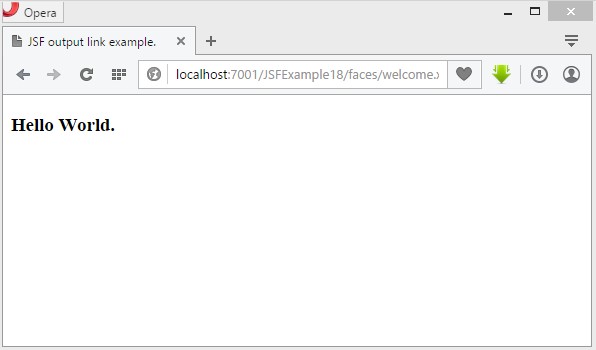JSF h:outputLink tag is used to render HTML anchor element. Value attribute specify the target URL.
JSF tag:
<h:outputLink value="nextPage">Click Here</h:outputLink> |
Rendered HTML tag:
<a href="nextPage.xhtml">Click Here</a> |
Note:
1. The “h:link” tag is useful to generate a link which requires to interact with the JSF “outcome” , but lack of “action” support make it hard to generate a dynamic outcome.
2. The “h:commandLink” tag is suck, the generated JavaScript is really scary! Not recommend to use this tag, unless you have a solid reason to support. But it supports the “action” attribute, which is what “h:link” lack of.
3. The “h:outputLink” is useful to generate a link which does not require to interact with the JSF program itself.
Attributes of h:outputlink tag.
| Attribute | Description |
|---|---|
| id | id for the tag |
| binding | Reference to the component used in a backing bean |
| rendered | A boolean value; false would suppress rendering |
| styleClass | Cascading stylesheet (CSS) class name |
| value | value binding |
| valueChangeListener | A method binding that responds to value changes |
| converter | Converter class name |
| validator | Class name of a validator attached to the component |
| required | A boolean; if true, marks the tag as required |
| accesskey | gives focus to an element |
| accept | Comma-separated list of content types for a form |
| accept-charset | Comma- or space-separated list of character encodings for a form. |
| alt | Alternative text for nontextual elements such as images |
| border | Pixel value for an element’s border width |
| charset | Character encoding for a linked resource |
| coords | Coordinates for an element whose shape is a rectangle, circle, or polygon |
| dir | Direction for text. Valid values are ltr (left to right) and rtl (right to left). |
| hreflang | Base language of a resource specified with the href attribute; |
| lang | Base language of an element’s attributes and text |
| maxlength | Maximum number of characters for text fields |
| readonly | Read-only state of an input field |
| rel | Relationship between the current page and linked page |
| rev | Reverse link from the anchor specified with href to the current document. |
| style | Inline style information |
| tabindex | Numerical value specifying a tab index |
| target | The name of a frame in which a document is opened |
| title | A title used for accessibility. Browsers typically create tooltips for the title’s value |
| type | Type of a link; for example, stylesheet |
| width | Width of an element |
| onblur | Event handler for losing focus |
| onchange | Event handler for value changes |
| onclick | Event handler for Mouse button clicked over the element |
| ondblclick | Event handler for Mouse button double-clicked |
| onfocus | Event handler for element received focus |
| onkeydown | Event handler for Key pressed |
| onkeypress | Event handler for Key pressed and released |
| onkeyup | Event handler for Key released |
| onmousedown | Event handler for Mouse button pressed |
| onmousemove | Event handler for mouse moved |
| onmouseout | Event handler for mouse left |
| onmouseover | Event handler for mouse moved onto |
| onmouseup | Event handler for mouse button released |
| onreset | Event handler for form reset |
| onselect | Event handler for Text selected |
Example:
test.xhtml
<?xml version="1.0" encoding="UTF-8"?> <!DOCTYPE html PUBLIC "-//W3C//DTD XHTML 1.0 Transitional//EN" "http://www.w3.org/TR/xhtml1/DTD/xhtml1-transitional.dtd"> <html xmlns="http://www.w3.org/1999/xhtml" xmlns:h="http://java.sun.com/jsf/html" xmlns:f="http://java.sun.com/jsf/core" xmlns:ui="http://java.sun.com/jsf/facelets"> <h:head> <title>JSF output link example.</title> </h:head> <h:body> <h3>JSF output link example.</h3> <h:form> <h:outputLink value="welcome.xhtml">Say Hello</h:outputLink> </h:form> </h:body> </html> |
welcome.xhtml
<?xml version="1.0" encoding="UTF-8"?> <!DOCTYPE html PUBLIC "-//W3C//DTD XHTML 1.0 Transitional//EN" "http://www.w3.org/TR/xhtml1/DTD/xhtml1-transitional.dtd"> <html xmlns="http://www.w3.org/1999/xhtml" xmlns:h="http://java.sun.com/jsf/html" xmlns:f="http://java.sun.com/jsf/core" xmlns:ui="http://java.sun.com/jsf/facelets"> <h:head> <title>JSF output link example.</title> </h:head> <h:body> <h3>Hello World.</h3> </h:body> </html> |
faces-config.xml
<?xml version="1.0" encoding="windows-1252"?> <faces-config version="2.0" xmlns="http://java.sun.com/xml/ns/javaee" xmlns:xi="http://www.w3.org/2001/XInclude" xmlns:xsi="http://www.w3.org/2001/XMLSchema-instance" xsi:schemaLocation="http://java.sun.com/xml/ns/javaee http://java.sun.com/xml/ns/javaee/web-facesconfig_2_0.xsd"> </faces-config> |
web.xml
<?xml version="1.0" encoding="UTF-8"?> <web-app version="3.0" xmlns="http://java.sun.com/xml/ns/javaee" xmlns:xsi="http://www.w3.org/2001/XMLSchema-instance" xsi:schemaLocation="http://java.sun.com/xml/ns/javaee http://java.sun.com/xml/ns/javaee/web-app_3_0.xsd"> <servlet> <servlet-name>faces</servlet-name> <servlet-class> javax.faces.webapp.FacesServlet </servlet-class> </servlet> <servlet-mapping> <servlet-name>faces</servlet-name> <url-pattern>/faces/*</url-pattern> </servlet-mapping> </web-app> |
URL:
http://localhost:7001/JSFExample18/faces/test.xhtml
Output:

Click on Say Hello link.

Download this example.